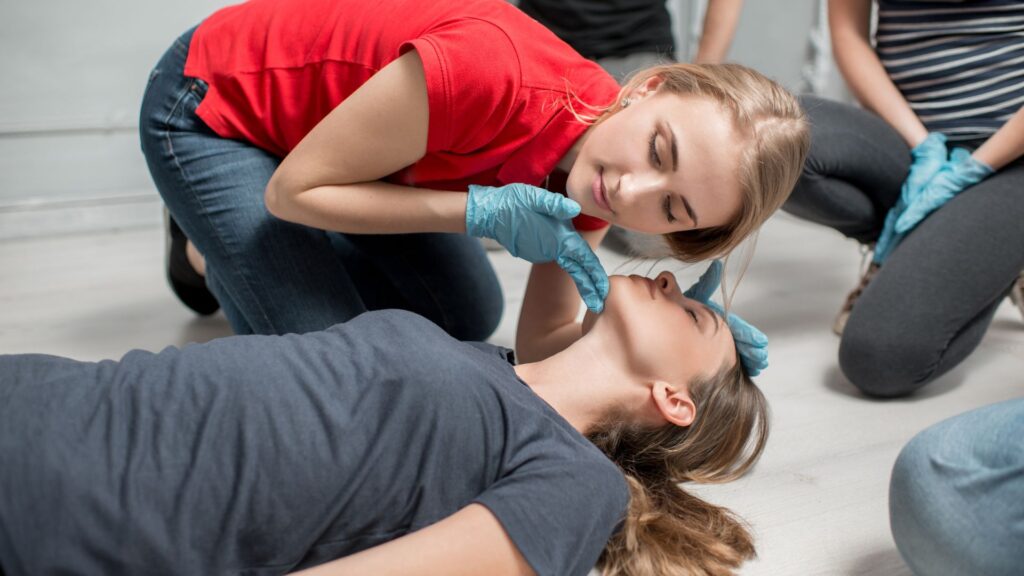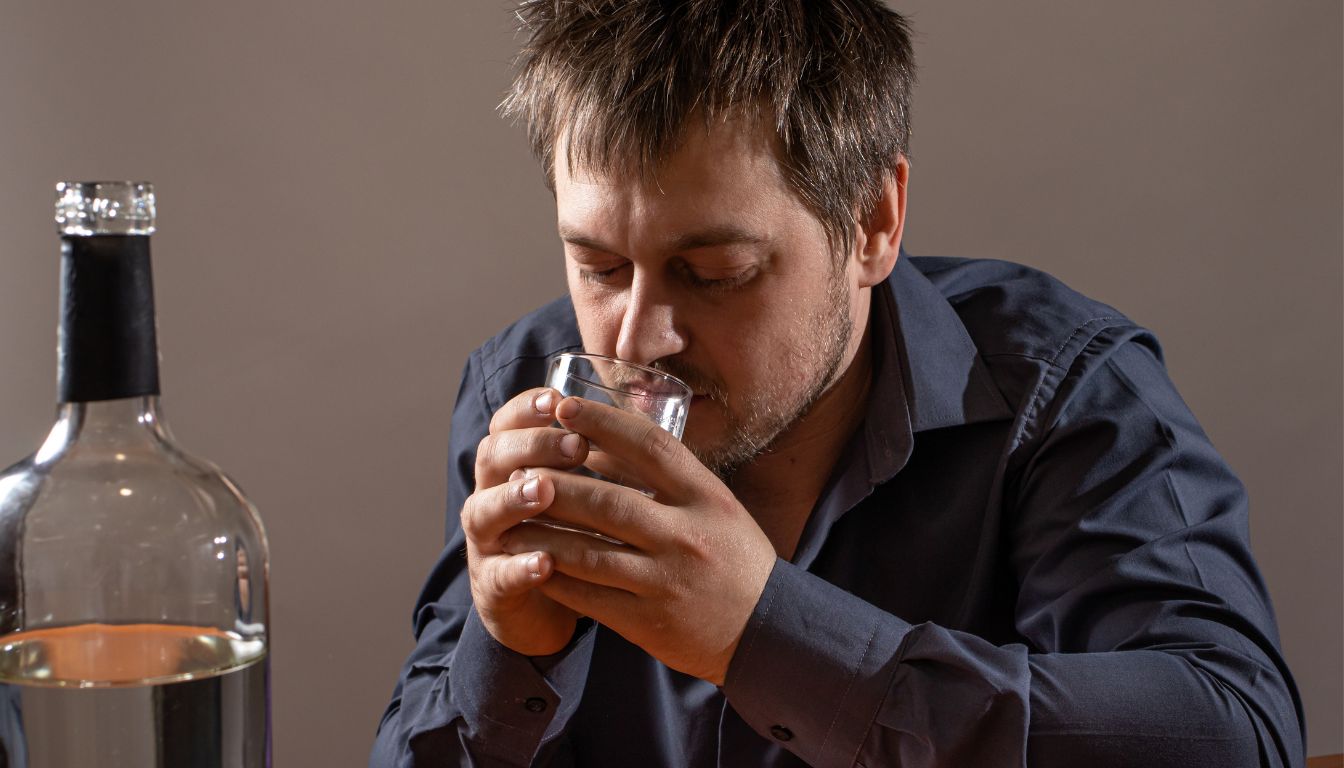Facing an alcohol overdose can be terrifying, both for the person experiencing it and for those around them. It’s a situation that demands immediate attention and the right actions to ensure safety and health.
Alcohol poisoning, as it’s medically termed, doesn’t just happen; it’s the result of consuming too much alcohol in a short amount of time.
One key fact to keep in mind is that symptoms like confusion, vomiting, and slow breathing are red flags signaling urgent medical care. Our guide walks you through not just recognizing these signs but also how to respond effectively – from calling emergency services to providing essential first aid until help arrives.
Ready to learn? Keep reading.
Key Takeaways
- Call 911 right away if you think someone has alcohol poisoning. Keep them awake, sitting up, and give water if they can drink.
- Never leave the person alone. Watch for severe signs like vomiting or seizures to keep them safe until help comes.
- Lay the person on their side to prevent choking if they vomit and check regularly for breathing and pulse.
- Doctors use medications like naltrexone, acamprosate, or disulfiram to treat long-term alcohol use disorder besides immediate overdose care.
- For recovery support, SAMHSA’s National Helpline offers free advice on treatment options 24/7 for those facing substance issues.
Understanding Alcohol Overdose

Alcohol overdose happens when you drink more alcohol than your body can safely handle. It can lead to serious health problems and even death.
What is alcohol poisoning/overdose?
Alcohol poisoning, also known as an overdose, occurs when someone drinks a large amount of alcohol in a short time. This condition is serious and can be deadly. The body struggles to process the alcohol quickly enough, leading to toxic effects.
Key symptoms include vomiting, seizures, confusion, slow breathing, hypothermia (low body temperature), and unconsciousness. Immediate medical care is necessary since these signs indicate potential respiratory depression or brain shutdown.
Taking prompt action is crucial for someone experiencing this condition. First aid involves ensuring the person’s airway remains clear and they continue breathing while waiting for medical help to arrive.
Treatment often focuses on supportive care in a hospital setting because there’s no quick fix or antidote for alcohol intoxication. Medications approved by the U.S. FDA—acamprosate, disulfiram, and naltrexone—are available but are part of longer-term management for alcohol use disorder rather than immediate treatment for poisoning.
Signs and symptoms
After learning what alcohol poisoning or overdose is, it’s crucial to recognize the signs and symptoms. Spotting these early can save lives.
- Confusion often shows up first, leaving the person disoriented and unable to make clear decisions.
- Vomiting is a sign that the body is trying to rid itself of the toxic effects of too much alcohol.
- Seizures may occur due to the severe impact of alcohol on the brain’s normal functions.
- Slow or irregular breathing is a dangerous symptom, showing that the body’s normal functions are failing.
- Hypothermia, or a dangerously low body temperature, can develop as alcohol disrupts the body’s heat regulation system.
- Unconsciousness means the person has lost consciousness and cannot be awakened; this requires immediate medical attention.
- Blue-tinged or pale skin indicates that oxygen levels in the blood may be dangerously low, another effect of heavy drinking.
Each sign points to the need for urgent care to prevent potentially life-threatening outcomes. Prompt recognition and action can make all the difference in treating someone with an alcohol overdose.
Complications and risks
Alcohol poisoning is not just a temporary state of drunkenness; it’s a critical condition that can shut down the brain and vital bodily functions. Risks include choking on vomit, which can lead to death by asphyxiation.
Slow or irregular breathing can further reduce oxygen to the brain, causing lasting damage. Excessive alcohol in the bloodstream messes with the body’s temperature regulation, leading to hypothermia—a dangerous drop in body temperature.
Complications from an overdose might escalate quickly, resulting in seizures due to low blood sugar levels. This dire scenario underscores why immediate medical intervention is paramount for survival and recovery.
Each moment counts, setting off a race against time to prevent permanent injury or worse.
Understanding symptoms and taking swift action are key in preventing alcohol overdose tragedies.
Emergency Actions for Alcohol Overdose

When someone overdoses on alcohol, quick action can save their life. Always call for help right away and keep the person safe until help arrives.
Call for help
Immediately call 911 if you suspect someone has alcohol poisoning. This condition is dangerous and can lead to death if not treated quickly. The symptoms—like confusion, vomiting, seizures, slow breathing, hypothermia, and unconsciousness—are serious warnings.
Since alcohol overdose shuts down areas of the brain that control vital life functions, getting medical help fast is critical.
Keep the person awake and sitting up while you wait for emergency responders. Give them water if they can drink it. Do not try to make them vomit because this could block their airway or cause choking.
Ensuring they get professional help as soon as possible can save their life.
Do not leave the person alone
Keep the person with you at all times. It’s crucial because alcohol overdose can suddenly get worse, leading to life-threatening problems like respiratory depression—where breathing slows down or stops.
Their safety is in your hands; staying with them means you can react fast if their condition changes. Make sure they’re awake and responsive. If they start showing severe signs of alcohol poisoning—vomiting, seizures, or unconsciousness—you’ll be there to help and ensure they don’t hurt themselves.
“Immediate medical attention is crucial for alcohol poisoning as it can be life-threatening.” This quote highlights the importance of not leaving someone alone during such a critical time.
Your presence could make all the difference, ensuring that complications are spotted early and help is provided swiftly to prevent serious outcomes like brain shutdown from excessive drinking.
Check for breathing and pulse
First, lean close to the person’s mouth and watch their chest for any sign of breathing. See if you can feel or hear their breath. Checking pulse involves pressing gently on the side of their neck or wrist, looking for a steady beat.
If there’s no sign of either, immediate action is needed—call emergency services right away.
Lay them on their back and keep checking for any change in their condition while waiting for help. Time is crucial here; without enough oxygen, brain damage could start within minutes.
Keep calm and stay focused until professionals arrive to take over.
Position the person properly
Place the person on their side to keep their airway clear. This position prevents them from choking if they vomit. Make sure their head is tilted back slightly to help them breathe better.
Keep checking they are breathing and have a pulse until medical help arrives.
Next, cover them with a blanket to keep warm but avoid overheating. Keeping the person safe and comfortable is crucial while waiting for emergency services that will address alcohol overdose treatment efficiently.
Treatment for Alcohol Overdose
Treating an alcohol overdose requires immediate medical attention. Doctors might use specific medicines to help clear the alcohol from a person’s system or support their breathing until they recover.
Medications for alcohol use disorder
Alcohol use disorder (AUD) is a medical condition that requires attention and care. The U.S. FDA has approved three medications specifically to help manage and treat AUD, making recovery more attainable for those affected.
- Naltrexone: This medication works by blocking the euphoric effects and feelings of intoxication. It helps individuals reduce drinking behavior by taking away the pleasure associated with alcohol consumption. People can take naltrexone as a daily pill or as a monthly injection under the brand name Vivitrol.
- Acamprosate (Campral): Designed to help those who have stopped drinking maintain abstinence, acamprosate eases the emotional and physical distress that can follow alcohol withdrawal such as anxiety or insomnia. It operates by restoring a chemical balance in the brain of those with AUD.
- Disulfiram (Antabuse): Unlike naltrexone and acamprosate, disulfiram works by causing a severe adverse reaction when someone drinks alcohol. After taking disulfiram, consuming even a small amount of alcohol will trigger symptoms like nausea, headache, and flushing. This aversive technique makes the idea of drinking less appealing.
Each of these medications offers a different approach to treatment, allowing individuals and healthcare professionals to choose what best fits their recovery journey. Their effectiveness increases significantly when combined with counseling and behavioral therapies, addressing both the physical and psychological aspects of addiction.
Counseling and behavioral therapies
Counseling and behavioral therapies play a key role in treating alcohol use disorder. These strategies help individuals change their drinking behaviors and solve related problems.
- Cognitive Behavioral Therapy (CBT) teaches people to recognize and avoid situations that lead to drinking. It focuses on developing coping skills to deal with life challenges without alcohol.
- Motivational Interviewing (MI) boosts a person’s motivation to change their drinking habits. Counselors support clients in identifying their readiness to change, enhancing motivation, and setting achievable goals.
- Marital and Family Counseling incorporates families into the treatment process. This can improve relationships and create a supportive environment for change.
- Group Therapy provides peer support from others who are facing similar challenges with alcohol use disorder. Sharing experiences and coping strategies can be very helpful.
- Brief Interventions involve short, one-on-one counseling sessions focused on reducing or stopping alcohol consumption. These are often used for individuals who may not have severe addiction but who are at risk.
- Medication-Assisted Treatment (MAT) combines medications like naltrexone, acamprosate, or disulfiram with counseling and behavioral therapies. MAT helps reduce cravings and withdrawal symptoms, making it easier to focus on recovery.
- 12-Step Facilitation is a structured approach that encourages participation in groups like Alcoholics Anonymous (AA). It emphasizes acceptance, surrender, active involvement in meetings, and working through the steps as keys to recovery.
- Mindfulness-Based Relapse Prevention (MBRP) focuses on increasing awareness of triggers, destructive habitual patterns, and automatic reactions that seem to control someone’s life. This technique teaches mindfulness practices as a way to cope with stress without resorting to alcohol.
- Co-Occurring Disorders Treatment addresses both alcohol use disorder and any other mental health issues simultaneously. It ensures that treatment for all conditions is integrated rather than treating each disorder separately.
Each of these methods has been shown effective in treating alcohol abuse complications, offering a pathway out of the cycle of addiction for many individuals struggling with alcohol use disorders.
Co-occurring disorders
People often face not just alcohol use disorder but also co-occurring disorders. These are when someone has both mental health issues and substance abuse problems at the same time.
It’s a complex situation that requires specialized treatment for both conditions.
Effective treatment addresses all of the patient’s needs, including their substance use and any co-occurring mental health disorders.
The FDA has approved three medications to help with alcohol use disorder—acamprosate, disulfiram, and naltrexone. Alongside these treatments, counseling and behavioral therapies play a crucial role in managing co-occurring disorders.
Addressing mental health is key to preventing relapses into substance abuse.
Preventing alcohol overdose includes understanding its dangers and knowing how to limit consumption.
Prevention of Alcohol Overdose
Knowing how to prevent alcohol overdose can save lives. It starts with making smart choices about drinking, like setting limits and not mixing alcohol with other drugs.
Setting limits on alcohol consumption
Setting limits on alcohol consumption plays a crucial role in preventing alcohol overdose, a serious condition that can lead to death. One must understand their own drinking patterns and recognize when to say no.
Keeping track of how much alcohol is consumed helps in avoiding the rapid intake of large amounts, which often leads to poisoning. Experts recommend defining clear boundaries before starting to drink and sticking to them throughout.
Drinking slowly and alternating alcoholic beverages with water can also lower the risk of an overdose. This approach not only reduces alcohol’s effects on the body but ensures hydration, mitigating some negative impacts of alcohol consumption.
With three medications approved by the U.S. FDA for treating alcohol use disorder—acamprosate, disulfiram, and naltrexone—it’s evident that medical science takes this issue seriously; prevention remains key.
Moving forward, understanding how to avoid binge drinking becomes essential in maintaining these limits effectively.
Avoid binge drinking
Binge drinking increases the risk of alcohol overdose, a condition where the body can’t handle the amount of alcohol consumed in a short time. It’s vital to know that binge drinking can lead to serious health problems like confusion, vomiting, seizures, and even unconsciousness.
These symptoms signal the need for immediate help because they show how quickly things can turn dangerous.
Setting personal limits on alcohol intake is a key step in preventing these risks. Instead of following peer pressure or social cues, listen to your body and recognize when it’s time to stop.
Understanding that an alcohol overdose could shut down your brain or cause hypothermia makes it clear why moderation is crucial.
Avoid mixing alcohol with other substances
Mixing alcohol with other substances, like opioids or sedative-hypnotic medications, greatly increases the risk of an overdose. This dangerous combination can lead to severe complications, including the shutdown of the brain and respiratory depression.
Alcohol alone already poses significant risks but combining it with these substances can be deadly. The U.S. FDA has approved three medications for treating alcohol use disorder—acamprosate, disulfiram, and naltrexone—but none are designed to counteract this lethal mix directly.
Immediate medical attention is crucial for alcohol poisoning.
Now let’s explore some myths surrounding alcohol overdose.
Debunking Myths About Alcohol Overdose
Exploding myths about alcohol overdose can save lives—know the facts, and keep reading for real solutions.
Common misconceptions about alcohol poisoning
Many think sleeping off alcohol poisoning is safe, but it’s dangerous. Unconscious individuals can choke on their own vomit or experience severe respiratory depression. Another myth is that cold showers, coffee, or walking it off can reverse the effects of alcohol overdose.
These methods do not reduce the alcohol level in the bloodstream and can worsen hypothermia symptoms, one of the critical signs of ethanol toxicity.
Some believe only heavy drinkers face a risk of overdose—incorrect. Even someone who rarely drinks can suffer from alcohol poisoning if they consume a large amount in a short period.
The U.S. FDA has approved three medications for treating alcohol use disorder—acamprosate, disulfiram, and naltrexone—highlighting medical recognition and intervention options beyond emergency care for acute incidents.
The truth about treatment options
Treatment options for alcohol overdose focus on keeping the person safe and stabilizing their condition. Doctors might use various methods such as pumping the stomach or giving fluids through an IV to treat dehydration and low blood sugar levels.
For those with alcohol use disorder, three medications approved by the U.S. FDA—acamprosate, disulfiram, and naltrexone—can help control addiction. Counseling and behavioral therapies also play a critical role in treatment, offering strategies to change drinking behavior.
Co-occurring disorders often complicate recovery from alcohol overdose and require specialized attention. Medical teams work closely to address both the physical effects of alcohol toxicity and any underlying mental health issues.
Immediate medical care is essential for survival and long-term recovery, highlighting the importance of understanding signs of overdose and seeking help quickly.
Immediate medical attention is crucial for alcohol poisoning, as it can be life-threatening.
Resources for Substance Abuse and Addiction
For those looking for help with substance abuse and addiction, numerous resources are at your fingertips—reach out and find the support you need to start on the path to recovery.
SAMHSA’s National Helpline
SAMHSA’s National Helpline is a free, confidential service available 24/7 for individuals and families facing mental and/or substance use disorders. This helpline offers support in English and Spanish, providing information on treatment options and referral services across the United States.
It serves as a crucial resource for those dealing with alcohol overdose incidents by guiding them to immediate help and long-term recovery solutions.
Reaching out to this helpline connects people to trained professionals who understand addiction. They can offer insights into medications approved by the U.S. FDA for alcohol use disorder—acamprosate, disulfiram, and naltrexone—and advise on counseling or behavioral therapies.
With its wide network, SAMHSA’s National Helpline ensures that no one has to find the path from alcohol overdose to recovery alone.
Other support options
Local community groups and online forums offer additional layers of support for those struggling with alcohol overdose concerns. These resources can connect individuals to shared experiences, advice on overcoming the challenges of addiction, and encouragement from others who have faced similar struggles.
Peer support plays a crucial role in recovery by providing a sense of belonging and understanding that traditional medical treatments sometimes miss.
Professional organizations outside of SAMHSA also give detailed guides and assistance for substance abuse rehabilitation. Facilities such as Alcoholics Anonymous (AA) or Sobriety groups bring people together under a common goal: sustained recovery from alcohol use disorder.
Engaging with these communities introduces accountability partners, sober activities, and mentors who have navigated the path to sobriety successfully. They emphasize the importance of continuous care and personal growth beyond initial treatment—a critical aspect often overlooked in discussions about alcohol poisoning recovery.
Conclusion
Dr. Alex Rendon brings over two decades of expertise to the forefront of alcohol abuse research and treatment — a true authority in addiction medicine. With a strong educational background, including an MD from Harvard Medical School and a Ph.D. in psychological studies related to addiction, Dr. Rendon’s career is marked by pioneering contributions to behavioral therapy approaches for alcohol use disorder.
In his analysis, Dr. Rendon emphasizes that “Immediate Actions For Alcohol Overdose: Comprehensive Guide, Supplements, Medicines” offers critical insights into timely and effective interventions for alcohol poisoning — life-saving knowledge when minutes count.
He points out that understanding the signs of overdose and knowing how to respond appropriately can drastically improve outcomes, based on solid scientific principles.
Dr. Rendon stresses the importance of safety, ethics, and transparency in addressing substance abuse issues. Certifications in medical professionals handling these cases ensure adherence to health standards while ethical considerations are crucial in providing non-judgmental support for patients suffering from alcohol overdoses.
He also recommends integrating strategies from this guide into daily routines or specific contexts like social gatherings where alcohol is consumed heavily might reduce instances of overdose through prevention education.
Nevertheless, Dr. Rendon presents a balanced view noting that while this comprehensive guide is invaluable as an immediate resource during emergencies; it should be complemented with long-term treatments such as medications approved by the U.S FDA—acamprosate, disulfiram, naltrexone—and counseling or behavioral therapies for lasting recovery from alcohol use disorder.
Finally, Dr. Rendon concludes that “Immediate Actions For Alcohol Overdose: Comprehensive Guide” stands out as essential reading for individuals seeking quick interventions and healthcare providers aiming at improving their emergency response capabilities against alcohol-related emergencies among other options available in the market today.
FAQs
1. What immediate actions should be taken for alcohol overdose?
In the face of an alcohol overdose, it’s crucial to act quickly and efficiently. The first step is to ensure the person’s safety by preventing further consumption of alcohol. Next, seek urgent medical attention as this situation can turn fatal if not addressed promptly.
2. How can supplements help in case of an alcohol overdose?
Certain dietary supplements are known to assist in managing symptoms related to alcohol overdoses such as dehydration and nutrient deficiencies. However, these should never replace professional medical care but rather serve as a supportive measure under expert guidance.
3. Are there specific medicines that can treat an alcohol overdose?
Yes, there are medicines specifically designed to treat cases of acute intoxication or chronic misuse leading to overdoses like Naloxone and Flumazenil among others – but only a healthcare provider can administer them safely.
4. Can I use this comprehensive guide for self-treatment during an alcohol overdose?
While this guide provides valuable information about initial steps, supplements and medication used in treating an alcohol overdose; it doesn’t substitute professional medical advice or treatment — always contact emergency services immediately when dealing with potential overdoses.
General Facts
1. Alcohol poisoning is a serious and potentially deadly condition that occurs when large amounts of alcohol are consumed in a short period of time.
2. Symptoms of alcohol poisoning include confusion, vomiting, seizures, slow or irregular breathing, hypothermia, and unconsciousness.
3. Immediate medical attention is crucial for alcohol poisoning, as it can be life-threatening.
4. The first priority in treating alcohol poisoning is airway protection and maintaining breathing to prevent respiratory depression.
5. There are three medications approved by the U.S. FDA to treat alcohol use disorder: acamprosate, disulfiram, and naltrexone.
6. Alcohol use and the use of opioids or sedative-hypnotic medications can increase the risk of alcohol overdose.
7. Alcohol overdose can lead to the shutdown of the brain and can have serious complications.
8. Understanding the dangers of alcohol overdose is important, especially in relation to the consumption of large amounts of alcohol in a short period of time.
9. Treatment for acute alcohol toxicity is largely supportive, and immediate medical care is necessary.
10. It is important to be aware of the symptoms and causes of alcohol poisoning, as well as the potential complications that can arise from alcohol overdose.
Source URLs
- Mayo Clinic: Alcohol Poisoning Diagnosis and Treatment
- NIAAA: Understanding the Dangers of Alcohol Overdose
- WebMD: Alcohol Poisoning Overview
- Mayo Clinic: Alcohol Poisoning Symptoms and Causes
- Cleveland Clinic: Alcohol Poisoning
- American Academy of Family Physicians: Alcohol Poisoning
- NCBI: Alcohol Poisoning Research Article

